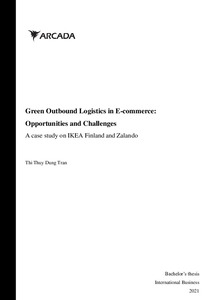Green Outbound Logistics in E-commerce: Opportunities and Challenges. A Case Study on IKEA Finland and Zalando
Tran, Dung (2021)
Tran, Dung
2021
All rights reserved. This publication is copyrighted. You may download, display and print it for Your own personal use. Commercial use is prohibited.
Julkaisun pysyvä osoite on
https://urn.fi/URN:NBN:fi:amk-2021052110283
https://urn.fi/URN:NBN:fi:amk-2021052110283
Tiivistelmä
Green logistics term was created as a result of these ecological recognition progress. More importantly, although logistics distribution has been increasingly mature and standardized, e-commerce is still considered to pose enormous challenges for companies in their pursuit of green logistics, where outbound logistics has been considered as the most important aspect to look at. This thesis aims to acknowledge benefits and challenges that e-commerce has brought up in terms of outbound logistics, precisely transportation, packaging, and reverse logistics under perspectives of companies. Followed is comparative analysis of similarities and differences in the perceptions of multi-channel retailers and e-tailers under the influence of e-commerce by looking through a case study of IKEA and Zalando. Key theories relating to Green logistics framework, its relation to Corportae Social Responsibility and Green Outbound Logistics practices in e-commerce development was introduced to gave a firm theoretical framework.
Semi-structured interview with case companies was suitable for this research study, allowing the author to gain deeper insights on internal logistics operations. Meanwhile, background history and other relevant data was collected via its sustainability reports as the secondary source.
The results indicate that both case companies perceive opportunities outweighing challenges brought by e-commerce, especially in green transportation and packaging. The use of renewable fuels, sustainable transportation vehicles and packaging material transformation into reusable cardboard, post-consumer recycled plastic are enhanced. Meanwhile, both companies have seen challenges in green packaging (questioning reliability of sustainable packaging materials during delivery) and customer communication (higher possibility of customers’ purchasing decisions being negatively changed due to extra costs charged and disclosure of information regarding eco-impacts in different delivery options). However, as IKEA and Zalando have been following different business models and markets, their perceptions about which aspects should be mostly focused on, which aspect is easy/difficult to go green are totally different. Precisely, multi-channel retailers are more likely to focus on green transportation and reverse logistics in e-commerce since there are different options for end-consumer product deliveries, which can lead to different eco-impacts. Meanwhile, e-tailers focus on green packaging due to increased customer interest groups and increased number of parcels needed to be delivered.
The research stopped at comparative analysis of case companies and was limited in the scope of investigating green outbound logistics from retailers with a focus on Finnish logistics systems. Further research on e-commerce impacts on green inbound logistics using mixed methods is recommended to increase the reliability and generalizability of empirical results on the topic.
Semi-structured interview with case companies was suitable for this research study, allowing the author to gain deeper insights on internal logistics operations. Meanwhile, background history and other relevant data was collected via its sustainability reports as the secondary source.
The results indicate that both case companies perceive opportunities outweighing challenges brought by e-commerce, especially in green transportation and packaging. The use of renewable fuels, sustainable transportation vehicles and packaging material transformation into reusable cardboard, post-consumer recycled plastic are enhanced. Meanwhile, both companies have seen challenges in green packaging (questioning reliability of sustainable packaging materials during delivery) and customer communication (higher possibility of customers’ purchasing decisions being negatively changed due to extra costs charged and disclosure of information regarding eco-impacts in different delivery options). However, as IKEA and Zalando have been following different business models and markets, their perceptions about which aspects should be mostly focused on, which aspect is easy/difficult to go green are totally different. Precisely, multi-channel retailers are more likely to focus on green transportation and reverse logistics in e-commerce since there are different options for end-consumer product deliveries, which can lead to different eco-impacts. Meanwhile, e-tailers focus on green packaging due to increased customer interest groups and increased number of parcels needed to be delivered.
The research stopped at comparative analysis of case companies and was limited in the scope of investigating green outbound logistics from retailers with a focus on Finnish logistics systems. Further research on e-commerce impacts on green inbound logistics using mixed methods is recommended to increase the reliability and generalizability of empirical results on the topic.
